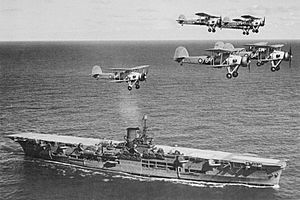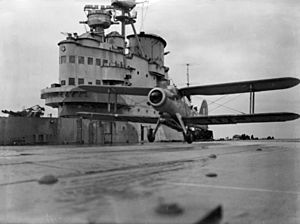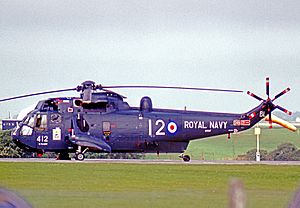820 Naval Air Squadron facts for kids
Quick facts for kids 820 Naval Air Squadron |
|
|---|---|
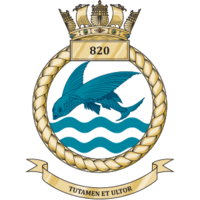
Squadron badge
|
|
| Active |
|
| Country | |
| Branch | |
| Type | Flying squadron |
| Role | Anti-submarine warfare |
| Part of | Fleet Air Arm |
| Home station | RNAS Culdrose |
| Motto(s) | Tutamen et ultor (Latin for 'Safeguard and avenger') |
| Aircraft | AgustaWestland Merlin HM2 |
| Commanders | |
| Current commander |
Commander Karen Snel MBE Royal Navy |
The 820 Naval Air Squadron is a special flying team in the Royal Navy. They are part of the Fleet Air Arm, which is the Navy's air branch. This squadron flies Merlin HM2 helicopters. Their main job is to find and stop enemy submarines. They are based at RNAS Culdrose and often fly from large aircraft carriers.
The squadron started on 3 April 1933. It was formed at RNAS Gosport when aircraft from two other flights, 450 Flight and 445 Flight, joined together.
Contents
The Squadron in World War II
When the 820 Squadron first started, their job was to help the aircraft carrier HMS Courageous. They would scout ahead and spot things for the ship. Over time, they got new aircraft like the Fairey Seal and Blackburn Shark. By late 1937, they were flying Fairey Swordfish planes.
In November 1938, the squadron moved to a new aircraft carrier, HMS Ark Royal. For the next three years, they worked from Ark Royal. At first, they hunted submarines. Later, they searched for enemy ships and launched torpedo attacks. The squadron went with Ark Royal to the Atlantic Ocean. In April 1940, they helped Allied forces in Norway, even bombing an airfield called Vaernes.
After leaving Norway, Ark Royal and the squadron moved to the Mediterranean Sea in June. Aircraft from 820 Squadron attacked the French fleet at Attack on Mers-el-Kébir. They also took part in the Battle of Dakar and attacked targets in Cagliari. They were active during the Battle of Cape Spartivento and helped protect important supply ships going to Malta.
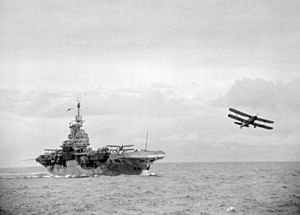
The squadron's next big mission was to hunt the German battleship Bismarck. Planes from 820 Squadron managed to hit Bismarck with a torpedo. This hit damaged the ship's steering, making it easier for other ships to attack and sink it. In June 1941, the squadron left Ark Royal. In November, they went to Iceland on HMS Victorious. Their Swordfish planes were then replaced with Fairey Albacores.
In February 1942, 820 Squadron joined HMS Formidable and sailed to the Indian Ocean. They were involved in the Battle of Madagascar and later Operation Torch. This was when Allied forces landed in North Africa. During these missions, their aircraft sank a German submarine, U-331. This submarine had earlier sunk the battleship HMS Barham. Formidable and the squadron stayed in the Mediterranean. They helped support the Allied landings in Sicily and Salerno.
The squadron returned to the UK in November 1943 and was temporarily stopped at RNAS Donibristle. However, they quickly started up again. They were given 12 Fairey Barracuda planes. At first, they were based at RNAS Lee-on-Solent. Their job was to be a torpedo bomber and reconnaissance squadron.
In June 1944, they joined HMS Indefatigable. They took part in Operation Mascot on 17 July and Operations Goodwood in August. These were attempts to sink the German battleship German battleship Tirpitz in Norway. The operations did not cause much damage to Tirpitz.
In September 1944, the squadron got 21 Grumman Avenger planes. They sailed with Indefatigable to the Far East in November. They went to Ceylon where 820 Squadron joined another group called No 2 Strike Wing. This group also included 849 Squadron. In January 1945, the Wing attacked oil refineries in Palembang, Sumatra, as part of Operation Meridian. After this, they attacked the Sakishima Gunto islands. As the war moved closer to Japan, 820 Squadron joined the 7th Carrier Air Group. They carried out several raids on Tokyo before VJ-Day, which marked the end of the war. After the war ended, Indefatigable stayed in the Pacific for a while. It finally returned to the UK in March 1946. 820 Squadron was then stopped again.
After the War: New Missions and Helicopters
The squadron started up again five years later in July 1951. This time, they were flying Fairey Firefly planes. In 1952 and 1953, the squadron flew from the carriers HMS Indomitable and HMS Theseus. They spent most of their time doing training exercises in the Mediterranean.
From 1954 to 1956, the squadron used Grumman Avenger and then Fairey Gannet planes. They flew from HMS Centaur and HMS Bulwark. Then, a decision was made to turn 820 Squadron into a helicopter squadron. 820 Squadron stopped on 2 December 1957. But they immediately started again on the same day at HMS Vernon. They were given Westland Whirlwind HAS.7 helicopters.
In May 1958, they joined HMS Hermes. Their job was to hunt submarines and support commando forces. They stayed on Hermes until October 1960, when the squadron was stopped again.
The squadron started again in 1964. They were given Westland Wessex HAS.1 helicopters. They served as an anti-submarine squadron on HMS Eagle. In May 1969, they upgraded to the Westland Wessex HAS.3. They then moved to the Tiger-class helicopter cruiser HMS Blake. They stayed on Blake until it was taken out of service in 1979. The squadron then joined HMS Hermes for the first few months of 1980.
Their helicopters were upgraded to the Westland Sea King HAS.1 in December 1972. Later, they got the HAS.2 version and then the HS.Mk.5 in December 1980. In early 1981, they joined HMS Invincible. Sadly, on 6 March 1981, two of their aircraft crashed in mid-air. Five of the eight crew members died.
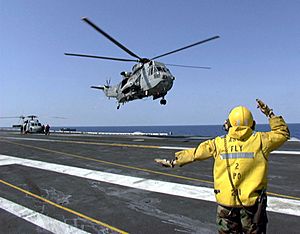
In April 1982, the squadron stayed on board for the Falklands War. During this conflict, the squadron flew for over 4,700 hours. Invincible stayed at sea for 166 days without stopping. This set a world record for continuous carrier operations.
The squadron moved to HMS Ark Royal in late 1985. In February 1990, they got new Sea King MK6 helicopters. On 10 January 1991, they were sent to the Eastern Mediterranean on Ark Royal. They planned to go through the Suez Canal to the Red Sea for Operation Granby. This was the UK's name for Desert Storm. However, the war started before they could get through the canal. So, Ark Royal stayed in the Eastern Mediterranean for the whole war.
In January 1993, 820 Squadron was sent on RFA Olwen and RFA Fort Grange. They went to support British forces in Bosnia as part of Operation Grapple. There, the squadron helped move people and supplies. 820 Squadron returned to Bosnia in 1994, this time on HMS Ark Royal.
When Ark Royal was taken out of service, the squadron joined HMS Illustrious. By 1996, they were in the eastern Atlantic. In 1997, they went on a trip around the world.
From 1998, while Illustrious was being repaired, 820 Squadron worked from RNAS Culdrose. They did anti-submarine training exercises. They also spent time on ships of the Royal Fleet Auxiliary. They rejoined Illustrious in 1999. They helped with relief efforts in Mozambique, on RFA Fort George. They also helped with Operation Palliser in Sierra Leone.
More training periods followed. In October 2004, they helped with a Search and Rescue mission. This was for the Canadian submarine HMCS Chicoutimi. It had been damaged by a fire and flooding off the west coast of Ireland.
The 820 Naval Air Squadron continues to train on Royal Navy and Royal Fleet Auxiliary ships. They also take part in military operations. They are based at RNAS Culdrose and fly the AgustaWestland Merlin HM.2 helicopter. Another squadron, 824 NAS, handles their training. Front-line duties are shared with 814 NAS. In 2014, 820 NAS temporarily helped the Commando Helicopter Force. This was while their troop-carrying squadrons were changing to the Merlin HC.4.
820 NAS is also known as the "Queen's squadron." They will be the main squadron to operate from the new Queen Elizabeth class aircraft carriers. In 2014, three Merlins from 820 NAS were sent on RFA Argus. This was the UK's response to the 2014 Ebola virus outbreak. 820 NAS will be a permanent part of HMS Queen Elizabeth's air group. On 3 July 2017, a Merlin Mk.2 helicopter from 820 NAS was the first aircraft to land on HMS Queen Elizabeth. It was piloted by 26-year-old Lieutenant Luke Wraith.
In 2020, 820 NAS took over all Merlin HM.2 operations from the Royal Navy's carriers. They took over the Airborne Surveillance role from 849 NAS. This means some of their aircraft will get the Crowsnest system. This system includes a new version of the Searchwater radar and the Cerberus mission system. It is designed so it can be installed in any Merlin helicopter.
The 820 Naval Air Squadron has used many different types of aircraft over the years. Here is a list of the aircraft they have operated:
| From | To | Aircraft | Version |
|---|---|---|---|
| April 1933 | 1933 | Fairey III | F |
| 1933 | May 1935 | Fairey Seal | |
| May 1935 | September 1937 | Blackburn Shark | |
| September 1937 | June 1941 | Fairey Swordfish | Mk.I |
| April 1939 | April 1939 | Fairey Battle | Mk.I |
| July 1941 | November 1943 | Fairey Albacore | Mk.I |
| January 1944 | October 1944 | Fairey Barracuda | Mk.II |
| October 1944 | March 1946 | Grumman Avenger | Mks.II & III |
| July 1951 | 1954 | Fairey Firefly | Mk.V |
| 1954 | 1956 | Grumman Avenger | AS.4 |
| 1956 | December 1957 | Fairey Gannet | AS.1 |
| January 1958 | May 1959 | Westland Whirlwind | HAS.7 |
| November 1959 | October 1960 | Westland Whirlwind | HAS.7 |
| September 1964 | May 1969 | Westland Wessex | HAS.1 |
| May 1969 | December 1972 | Westland Wessex | HAS.3 |
| December 1972 | January 1977 | Westland Sea King | HAS.1 |
| January 1977 | March 1980 | Westland Sea King | HAS.2 & HAS.2A |
| March 1980 | 1990 | Westland Sea King | HAS.5 |
| 1989 | March 2003 | Westland Sea King | HAS.6 |
| September 2001 | September 2013 | AgustaWestland Merlin | HM.1 |
| September 2013 | Present | AgustaWestland Merlin | HM.2 |
The 820 Naval Air Squadron has been recognized for its bravery and success in various battles. These recognitions are called battle honours.
- Norway 1940–41
- Spartivento 1940
- 'Bismarck' 1941
- Atlantic 1941
- Malta Convoys 1941
- North Africa 1942–43
- Sicily 1943
- Salerno 1943
- Palembang 1945
- Okinawa 1945
- Japan 1945
- Falkland Islands 1982


